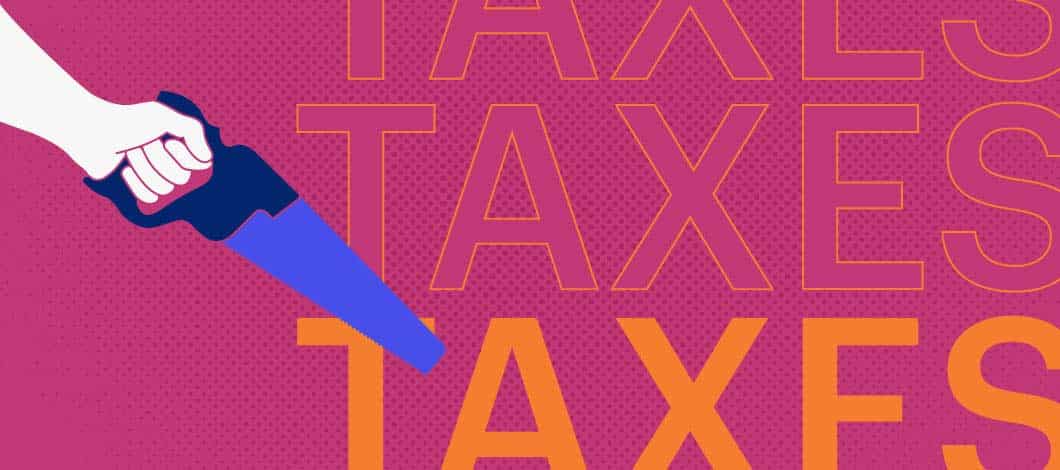Apart from the commonly cited strategy of saving roughly 30% of your income for business taxes, how else should you plan ahead?
Here are 9 small business tax-planning strategies you can implement to save money when it’s time to file.
- Plan ahead to avoid penalties
- Choose your optimal tax structure
- Decide whether to accelerate or defer income
- Determine whether to accelerate or defer expenses
- Review net operating loss deductions
- Determine if employee bonuses are deductible
- Use a retirement account to reduce taxable income
- Think about making charitable donations
- Consider working with a business tax expert

1. Plan Ahead to Avoid Penalties
Small businesses are responsible for meeting quarterly tax deadlines. You can use IRS Form 1040-ES to determine your estimated taxes. Filing your estimated taxes late or underpaying what you owe can result in penalties. Avoid these unnecessary expenses by planning ahead to pay your quarterly obligations on time.
If you’re short on funding to make deadlines, consider whether short-term business financing might help you cover your payments so you can avoid penalties.
2. Choose Your Optimal Tax Structure
The Tax Cuts and Jobs Act (TCJA) lowered the top corporate tax rate to a flat 21% of taxable income. This means that for some business owners in tax brackets with rates above 21%, you can save money by changing the structure of your business. (The TCJA legislation also repealed the corporate alternative minimum tax that had previously been in effect.)
Flow-Through Structures vs. C Corporations
Different business tax structures impose different tax rates on their owners. Flow-through entities, also known as pass-through entities, avoid paying corporate taxes by passing income on to business owners or investors, who are then taxed. Businesses classified as pass-through entities include sole proprietorships, partnerships, limited liability companies (LLCs) and S corporations.
In contrast, C corporations get taxed as businesses and their owners also pay taxes on any personal income received from the business.
Choosing Your Structure
Whether a pass-through structure or a C corporation will be more advantageous to you depends on the specifics of your situation. If you use a pass-through structure, the TCJA allows you to claim a 20% pass-through deduction.
Whether this will benefit you more than filing as a C corporation depends partly on your income level. Under current tax brackets, a 22% tax rate kicks in at an income above $41,775 for individuals or $83,550 for married couples filing jointly.
However, other factors besides tax savings can go into choosing the structure of your business. Consult a professional experienced with tax planning for companies to help you determine your most prudent strategy.
3. Decide Whether to Accelerate or Defer Income
One important business tax-planning decision can be whether to collect outstanding payments now so you can pay taxes on them this year or delay collection and payment until next year. Businesses typically use the cash method of accounting, which requires you to report any income you actually receive during the year as part of your gross income for that year.
Under the cash method, collecting and reporting payments this year can be advantageous if you expect your tax bracket to go up next year. However, if you expect to be in a lower tax bracket next year, it might make sense to delay invoicing a customer until after Dec. 31.
4. Determine Whether to Accelerate or Defer Expenses
Similar considerations apply when deciding whether to pay for small business expenses this year or next year. Expenses paid for this year will lower this year’s income, while those deferred until next year will reduce next year’s revenue.
If you expect your tax bracket to go up next year, it may be advantageous to hold off paying for an expense until then so you can claim the deduction. On the other hand, if you expect your tax bracket to go down, you might wish to claim the deduction this year. Consider this when deciding when to time tax-deductible purchases, such as equipment or supplies.

5. Review Net Operating Loss Deductions
Net operating loss deductions are available to C corporations, insurance companies and individuals. They allow eligible businesses to balance out losses in a given year by offsetting them with another year’s income. This benefits the business because it’s able to pay taxes on the net amount.
While the CARES Act provided for a special 5-year carryback for taxable years beginning in 2018, 2019 and 2020, currently the IRS notes, for losses arising in taxable years beginning after Dec. 31, 2020, the net operating loss deduction (NOLD) is limited to 80% of the excess (if any) of taxable income, which is “determined without regard to the deduction, QBID (qualified business income deduction) and Section 250 deduction over the total NOLD from NOLs arising in taxable years beginning before January 1, 2018.”
6. Determine If Employee Bonuses Are Deductible
Under Internal Revenue Code Section 461, you can claim deductions for bonuses paid to eligible employees. To qualify, bonuses must be paid to employees who aren’t considered self-employed, which excludes sole proprietors, LLC members and partners. In addition, you must withhold taxes on bonuses.
Bonus deductions are handled differently depending on whether you use the cash method of accounting or the accrual method, which records earnings and expenses when they occur, even if cash hasn’t yet changed hands. Talk to an accounting professional about how to handle your bonus deductions.
7. Use a Retirement Account to Reduce Taxable Income
Regulations regarding setting up and managing retirement plans are complex. However, if you contribute to a retirement account or set one up for your employees, you may be eligible for deductions. For example, under Internal Revenue Code Section 404, you can deduct contributions you make to employee 401(k) plans up to a specified limit. You can also claim tax credits for the costs of setting up certain types of retirement plans.
8. Think About Making Charitable Donations
Donations to one or more nonprofit groups categorized as 501(c)(3) organizations can be a way to do something good and potentially lower your taxable income. When choosing which organizations to donate to, consider which charities mean something to you (and your customers). Use the IRS search tool to help find tax-deductible charitable organizations.
According to the IRS, “To claim a deduction for contributions of cash or property equaling $250 or more, you must have a bank record, payroll deduction records or a written acknowledgment from the qualified organization showing the amount of the cash and a description of any property contributed and whether the organization provided any goods or services in exchange for the gift.”
9. Consider Working With a Business Tax Expert
In spite of all the business tax-planning tips we’ve noted, they don’t compare to the advice of an experienced tax professional. Also, remember that tax laws can change. Hiring someone who knows the ins and outs of business tax deductions and tax-planning strategies could mean the difference between paying the right amount of taxes or overpaying.
Additionally, even with tax preparation software, which many entrepreneurs use, mistakes are possible. Having a professional set of eyes reviewing your particular business circumstances could better mitigate the risk of error when filing your taxes.
Invest in Tax Preparation to Plan for a Profitable New Year
While tax preparation is never fun, investing in year-end tax planning can put you in a better financial position going into the new year. Use the tips outlined above to save your business money. And if you need funds to hire a tax adviser or cover upcoming tax obligations, consider financing options, such as a business line of credit or working capital loan.










